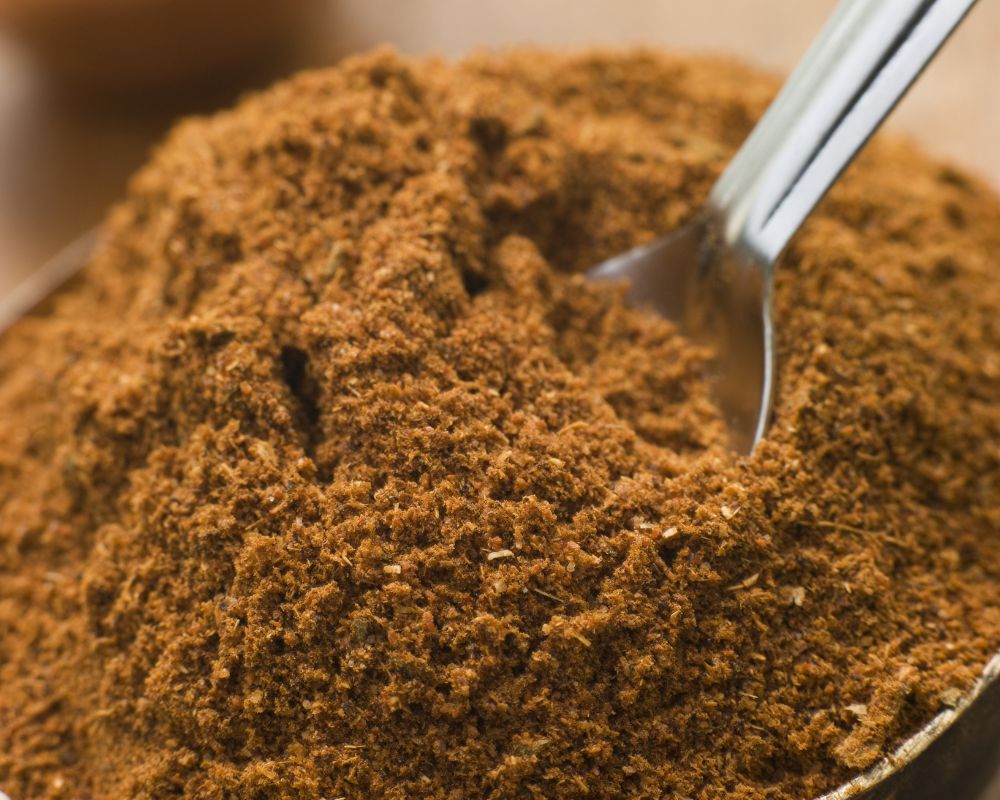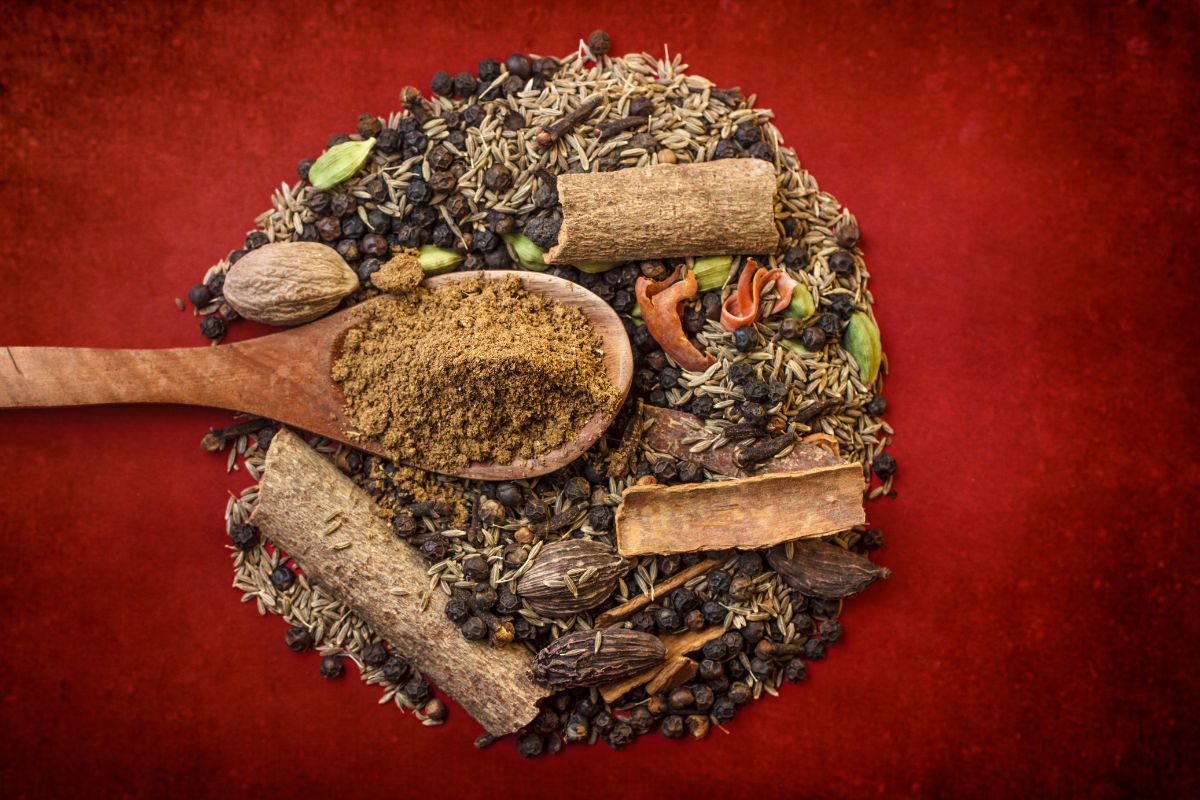Chaat masala (or chat masala) is a multipurpose Indian spice blend featuring seven basic spices, with three being the key ingredients providing saltiness, tartness, and spiciness. Although the complex flavor of chaat masala is challenging to replicate, tikka masala, garam masala, and dry mango powder are excellent chaat masala substitutes.
Table of Contents
Is chaat masala spicy?
Chaat masala is traditionally spicy, containing black pepper and red chili powder.
As a spice blend, chaat masala combines the various flavors of its individual ingredients to result in a complex flavor profile. It is tart, tangy, hot, zingy, salty, sour, and sweet. It also has a strong umami flavor.
The complex flavor profile of chaat masala makes it highly versatile as a spice mix. It is a staple in Pakistani and Indian cuisines, especially street food such as papri chaat, fruit chaat, and chana chaat.
Chaat masala is a seasoning spice for soups, chicken, fish, stews, roasting vegetables, and curries. The powdered spice mix works well as a dry rub for meats and corn cobs. You can also try garnishing French fries, fruits, and salad dressings.
What are the ingredients in chaat masala?
Chaat masala traditionally incorporates seven basic spices, three of which are key ingredients for its unique taste — including dried mango powder, red chili powder, and salt.
The number of ingredients in the dry spice mix usually differs from recipe to recipe, depending on the location and personal preferences.
You can expect chaat masala to feature the following ingredients:
| Dried mango powder | This brings the characteristic tart and tangy flavor of chaat masala |
| Salt (black salt and regular salt) | Both bring saltiness. Black salt also adds an umami flavor, while regular table salt offsets the strong flavor of black salt |
| Red chili powder | This spice packs the heat |
| Black peppercorns (black pepper) | This also adds heat to chaat masala |
| Cumin seeds | This spice has earthy, citrusy, nutty, smoky, licorice, and peppery flavors |
| Coriander seeds | This spice has earthy, citrusy, and nutty flavors |
| Dried pomegranate seeds | This spice almost tastes like tamarind and is sweet and tart |
Some chaat masala recipes may include the following spices:
| Carom seeds (ajwain) | These have a bitter taste |
| Asafoetida/asafetida/hing (skip this if you want gluten-free chaat masala) | It has an onion-garlic flavor |
| Sugar | It adds sweetness to chaat masala |
| Garam masala | It has an earthy, warming taste |
| Citric acid | Has a sour, tart flavor |
| Dried ginger powder | Has citrusy and peppery flavors |
| Dried mint leaves | Have woodsy and sweet flavors with eucalyptus notes |
Chaat masala vs. garam masala: main differences
Despite the shared masala name, chaat masala differs from garam masala, another popular South Asian spice blend. The two spice mixes are different in taste, ingredients, and application.
Chaat masala is celebrated for its tartness, tanginess, sourness, and saltiness. These flavors are not present in garam masala, which is sweet, floral, earthy, and warm.
Garam masala uses warm spices such as cloves, coriander seeds, cardamom, cumin, ginger, red chili powder, and cinnamon. Besides cumin, red chili powder, and coriander seeds, chaat masala and garam masala do not share other ingredients.
You can use chaat masala to add tanginess and enhance the flavor of a dish, while garam masala enhances the flavor and aroma of dishes such as stews, curries, and rice.
Can I use garam masala instead of chaat masala?
Yes, you can use garam masala instead of chaat masala. However, the world is divided on whether these two spice blends should substitute each other.
People who discourage using the two spices alternatively say their flavor profiles are completely different.
Proponents of using spices interchangeably point out that although they have different tastes, garam masala makes a good chaat masala substitute because of its heat.
The heat in garam masala comes from red chili powder. If you care more for the heat rather than the tanginess, there’s no harm in substituting chaat masala with garam masala.
What can be used instead of chaat masala?
If you find yourself preparing a dish that requires chaat masala, but your spice rack fails you, here are eight hot substitutes to try:
- Tikka masala
- Curry powder
- Baharat
- Lemon juice
- Dry mango powder
- Dried pomegranate powder
- Black salt
- Homemade chaat masala
| Tikka masala | Features cumin seeds, coriander seeds, red chili powder, and black pepper, works for dishes such as chicken, vegetables, and soups |
| Curry powder | Shares ingredients such as coriander seeds, asafoetida, ginger, and cumin seeds, ideal for stews, vegetables, and soups |
| Baharat | Shares common ingredients with chaat masala, such as black pepper, dried mint, and coriander seeds, good for various dishes |
| Lemon juice | Offers a zesty flavor, works well with soups, vegetables, chicken, salad dressings, marinades |
| Dry mango powder | On its own, dry mango powder won’t replace chaat masala’s many flavors, so add some black pepper, use it for fish, stews, chicken, and tikka |
| Dried pomegranate powder | Dried pomegranate powder (anardana) is the best substitute for chaat masala, used in salads, curries, lamb, meats, chutneys, and chicken |
| Black salt | Tangy, goes well with fruit salads, raitas, amchur chutneys, and curry blends |
| Homemade chaat masala | Similar to store-bought, used in same recipes that call for the usual blend |
1. Tikka masala

As a related blend of spices, tikka masala features cumin seeds, coriander seeds, red chili powder, and black pepper. Some recipes incorporate dry mango powder.
Depending on the recipe, tikka masala shares four or five spices with chaat masala. The flavor profile isn’t exactly the same, and tikka masala has a strong flavor.
To get closer to the flavor of chaat masala, use a tikka masala containing dry mango powder. A little salt will also come in handy.
The tikka masala flavor takes time to develop, so you’ll want to use this substitute in cooking dishes such as chicken, vegetables, and soups.
Given the strong flavor of tikka masala, start with small amounts and add more to taste when using it to replace chaat masala.
2. Curry powder

Spice blends make good substitutes for chaat masala, and curry powder lives up to the task because it shares ingredients such as coriander seeds, asafoetida, ginger, and cumin seeds.
The shared ingredients depend on what the recipes for the two spice mixes feature. Curry powder that doesn’t include red chili powder lacks the heat desired in chaat masala.
Curry powder also scores as a chaat masala substitute because it has turmeric — the spice that gives it its earthy flavor and characteristic bright yellow color.
The downside to using curry powder as a substitute for chaat masala is that it doesn’t have salt and dry mango powder. You’ll have to add these two for your dish to mimic the chaat masala flavor more closely.
Use curry powder generously to replace chaat masala, but start small with a 1:1 ratio and then add more to taste.
You’ll want to use curry powder in cooked dishes for its flavor to develop fully. Use this substitute in stews, vegetables, and soups.
3. Baharat

When replacing chaat masala, baharat works well both in cooked dishes and as a condiment in salads. It shares common ingredients with chaat masala, such as black pepper, dried mint, and coriander seeds.
The spiciness in baharat comes from paprika. However, the spice lacks salt and dried mango powder, so your dish may lack the desired sourness.
Depending on the recipe, some baharat ingredients are strong, so you’ll want to use it sparingly to replace chaat masala. Start small and add to taste.
Use baharat to flavor cooking and cooked soups, stews, marinades, and dishes such as lamb, seafood, beef, vegetables, and chicken.
4. Lemon juice

You will want to use lemon juice as a chaat masala substitute because of its sour tartness. It adds some zing to a dish.
When you add some black salt, you get a zesty flavor. Other spices to add alongside lemon juice to get closer to the flavor of chaat masala include black pepper, coriander seeds, red chili pepper powder, and cumin.
Use lemon juice to replace chaat masala in soups, vegetables, chicken, salad dressings, marinades, and fish. Replace sparingly to avoid excess tartness and sourness.
5. Dry mango powder

Dried mango powder, also called amchur or amchoor powder, is derived from unripe mangoes. It makes chaat masala tangy and tart as its primary flavoring agent.
On its own, dry mango powder won’t replace chaat masala’s many flavors. Add some black pepper to your dish to make it spicy.
Use dry mango powder to add tanginess and zest to soups, curries, fruit salads, dal, and stir-fried vegetables. Sprinkle the fruity spice on dishes like fish, stews, chicken, and tikka.
Start with small amounts of dry mango powder and add to attain your preferred taste. Remember that too much of it will make your dish tart and tangy.
6. Dried pomegranate powder

The sweetness and tartness in chaat masala partly come from dried pomegranate powder obtained from dried seeds of pomegranate fruits. The tartness is, however, overtaken by that of dry mango powder.
Dried pomegranate powder (anardana) is the best substitute for chaat masala if you can’t find mango amchur powder to act as a souring agent. Use the vitamin C-loaded spice in salads, curries, lamb, meats, chutneys, and chicken.
Start with small amounts and keep adding the powder to suit your preferred taste.
7. Black salt

The umami flavor in chaat masala comes partly from the sulfur in black salt and partly from asafoetida if the latter is included in the recipe. The salt is also tangy, but its tanginess is outdone by that of dry mango powder in the spice blend.
Using black salt (called kala namak in India) necessitates adding some table salt to offset the strong salty flavor. The advantage is that, unlike common salt, black salt contains less sodium. It is handy if you are looking to control your sodium intake.
Substitute chaat masala with black salt to enhance the flavor of Indian dishes such as fruit salads, raitas, amchur chutneys, and curry blends.
Add black salt in small amounts until tasty as desired.
8. Homemade chaat Masala
The main advantage of using homemade chaat masala to substitute the store-bought version is that you can control the final flavors.
You can make your spice blend with more or fewer spices. Alternatively, you can mix the different spices in varying ratios.
The final flavor of your dish will depend on what flavors you choose to make more profound in the homemade spice blend. However, remember, it won’t really be chaat masala without the tanginess, saltiness, and spiciness.
Use homemade chaat masala in the same way as the store-bought version in dishes like biryani, dahi baray, raita, papri chaat, and chana masala.
Start with small amounts and add to taste.
How to make chaat masala at home?
To make chaat masala at home, use the following ingredients and instructions.
Ingredients:
- 6 tablespoons cumin seeds
- 2 tablespoons coriander seeds
- 8 tablespoons dry mango powder
- 2 teaspoons black peppercorns
- 4 tablespoons dried pomegranate seeds
- 2 teaspoons red chili powder
- 4 tablespoons black salt
- 1/2 teaspoon regular salt
- 2 teaspoons dried mint leaves (optional)
- 2 teaspoons carom seeds
- 1/2 teaspoon asafoetida
- 2 teaspoons dry ginger powder (optional)
Procedure:
- Dry-roast cumin seeds, black peppercorns, and coriander seeds in a cast-iron skillet for 2 minutes on medium heat. Leave them to cool for 10-15 minutes.
- Grind the black peppercorns, coriander seeds, and cumin seeds in a spice grinder.
- Add all the powdered spices, mix thoroughly, and grind to a fine powder.
- Store the powder in spice jars or airtight containers.
You can reduce the amount of each ingredient in half to reduce the number of servings and avoid wastage during prolonged storage.
How to store homemade chaat masala?
Store your homemade chaat masala in small airtight containers in a cool, dry place away from direct sunlight.
Since it doesn’t have anti-caking agents, homemade chaat masala may spoil sooner than its commercial counterpart. If you notice it getting clumpy, shake it to restore it.
Well-stored homemade masala lasts up to 3 months, but it starts losing its freshness by the 6-8th week.

